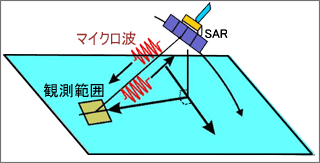Characteristics of SAR
Using SAR, we observe the ground surface with a radar antenna installed in a flying object such as a satellite or an airplane and create a image from the variation of a reflected wave which bounces back off the ground surface and understand topography, structures on the ground surface, etc. visually.
Unlike aerial photographs, the SAR observation can be made under any weather condition because a radio wave can penetrate cloud, etc.. Therefore it has a wide field of application including resource exploration. The best parameters (wavelength, etc.) for the purpose can also be specified, because SAR is a kind of active sensor which transmits a radio wave by itself, unlike the optical sensor which is a kind of passive sensor only recording light reflected off the ground.
In addition, we need to pay attention to the fact that SAR transmits and receives a radar wave in the obliquely downward direction, so the image directly under the SAR antenna cannot be obtained.
This is because SAR identifies a target by the difference of distance between SAR and the object. If SAR transmits a radio wave directly below, the waves reflected from the right and left side relative to the position directly under the satellite have the same distance and SAR cannot distinguish right from left.

Figure 3. Position relation between the SAR antenna and the ground
* SAR observes in the obliquely downward direction!